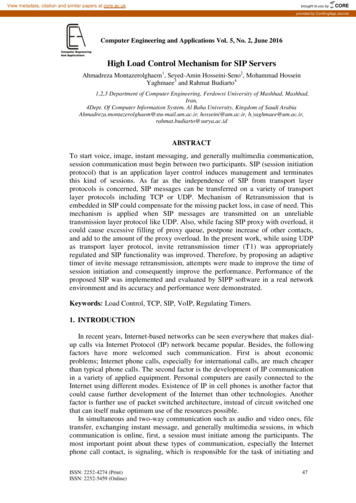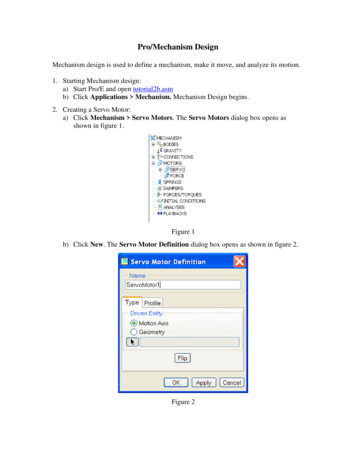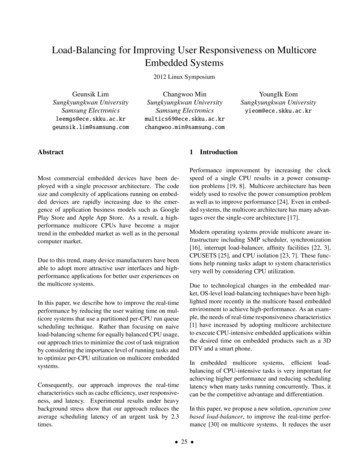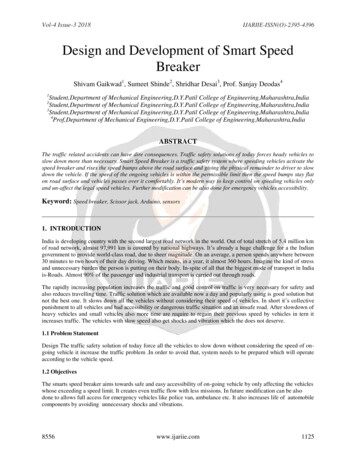
Transcription
View metadata, citation and similar papers at core.ac.ukbrought to you byCOREprovided by ComEngApp-JournalComputer Engineering and Applications Vol. 5, No. 2, June 2016High Load Control Mechanism for SIP ServersAhmadreza Montazerolghaem1, Seyed-Amin Hosseini-Seno2, Mohammad HosseinYaghmaee3 and Rahmat Budiarto41,2,3 Department of Computer Engineering, Ferdowsi University of Mashhad, Mashhad,Iran,4Dept. Of Computer Information System, Al Baha University, Kingdom of Saudi ArabiaAhmadreza.montazerolghaem@stu-mail.um.ac.ir, hosseini@um.ac.ir, TRACTTo start voice, image, instant messaging, and generally multimedia communication,session communication must begin between two participants. SIP (session initiationprotocol) that is an application layer control induces management and terminatesthis kind of sessions. As far as the independence of SIP from transport layerprotocols is concerned, SIP messages can be transferred on a variety of transportlayer protocols including TCP or UDP. Mechanism of Retransmission that isembedded in SIP could compensate for the missing packet loss, in case of need. Thismechanism is applied when SIP messages are transmitted on an unreliabletransmission layer protocol like UDP. Also, while facing SIP proxy with overload, itcould cause excessive filling of proxy queue, postpone increase of other contacts,and add to the amount of the proxy overload. In the present work, while using UDPas transport layer protocol, invite retransmission timer (T1) was appropriatelyregulated and SIP functionality was improved. Therefore, by proposing an adaptivetimer of invite message retransmission, attempts were made to improve the time ofsession initiation and consequently improve the performance. Performance of theproposed SIP was implemented and evaluated by SIPP software in a real networkenvironment and its accuracy and performance were demonstrated.Keywords: Load Control, TCP, SIP, VoIP, Regulating Timers.1. INTRODUCTIONIn recent years, Internet-based networks can be seen everywhere that makes dialup calls via Internet Protocol (IP) network became popular. Besides, the followingfactors have more welcomed such communication. First is about economicproblems; Internet phone calls, especially for international calls, are much cheaperthan typical phone calls. The second factor is the development of IP communicationin a variety of applied equipment. Personal computers are easily connected to theInternet using different modes. Existence of IP in cell phones is another factor thatcould cause further development of the Internet than other technologies. Anotherfactor is further use of packet switched architecture, instead of circuit switched onethat can itself make optimum use of the resources possible.In simultaneous and two-way communication such as audio and video ones, filetransfer, exchanging instant message, and generally multimedia sessions, in whichcommunication is online, first, a session must initiate among the participants. Themost important point about these types of communication, especially the Internetphone call contact, is signaling, which is responsible for the task of initiating andISSN: 2252-4274 (Print)ISSN: 2252-5459 (Online)47
Ahmadreza Montazerolghaem, Seyed-Amin Hosseini-Seno,Mohammad Hossein Yaghmaee and Rahmat BudiartoHigh Load Control Mechanism for SIP Serversmanaging each session. One of the very suitable protocols in this field is SIP, thetask of which is making, modifying, and terminating the session. One of the keycomponents in delay-sensitive applicable programs like voice and imagetransmission by the Internet is the time required for the session start-up, which ishighly effective in protocol efficiency. Reduction of this period of time leads toincrease in the SIP server transmission and consequently improves its efficiency. Onthe other hand, it will cause more user acceptability. Due to the importance of thisissue, some researchers have focused on reducing the necessary time for creating thesession in progress, some examples of which are mentioned below.This work aims to improve the session initiation time in UDP protocol by usingan appropriate regulation of timer and sending invite message retransmission in sucha way that the session initiation time will be improved and the number of missedcalls was reduced.The rest of this paper is organized as follows: Section 2 provides related works.Section 3 gives an overview to improve SIP efficiency while using UDP. Section 4presents the adaptive timer T1 including its estimation. Section 5 presents theimplementation of the proposed adaptive timer T1, followed by the experimentalresults and discussion. Lastly Section 6 concludes this paper.2. RELATED WORKSAs certain servers which are specified for SIP can be used for a session,increasing their number, load distribution among them, or their processing capabilitycan help reduce the time for session initiate [1]. It is worth knowing that thesechanges are costly and sometimes difficult. Another way is to apply stateless modeinstead of stateful in servers [2]. However, it has a major problem; a completehistory of communication will not be available [3]. Another method which can beused for reducing the time for session initiation is to remove user authenticationconfirmation, which has the highest positive impact on reducing the time of thesession initiation; however, due to the nature of the Internet network and thenecessity of using authentication confirmation in some cases, this method has someconsiderable problems as well. On the other hand, another important component,which must be considered, is the percentage of missed sessions, the reduction ofwhich evidently influences the protocol.Generally, with regard to compatibility in interoperability, UDP is considered thestandard transmission protocol for SIP; however, it should be considered that otherprotocols such as TCP and SCTP are also reliable and applicable [4] (in some cases,use of connection-oriented protocols are required: for example, in the circumstancesin which the length of SIP message transmission is more than its MTU [5]). Incontrast, according to the standard, all the implementations of SIP must back-upTCP and UDP [10]. Accordingly, by appropriately selecting transmission protocoland UDP as transmission layer protocol and by regulating SIP timers, someconditions can be provided for increasing the protocol effectiveness in variousnetwork conditions considering the amount of packet loss and delay and the amountof traffic load of SIP. Since the session initiator can determine the transmissionprotocol, the responder complies with it, and this selection is decided in each nodeof the SIP network, therefore, some measures can be done at each point of thenetwork considering the network conditions for selection [6]. In this case, selectionis done dynamically; without spending certain expense, transmission can beincreased and as a result high efficiency is obtained.48ISSN: 2252-4274 (Print)ISSN: 2252-5459 (Online)
Computer Engineering and Applications Vol. 5, No. 2, June 20163. IMPROVING SIP EFFICIENCY USING UDPIn this work, a situation was considered in which, due to some reasons, UDP wasassumed as transmission layer protocol for SIP. In this situation, the regulationswere so that the efficiency of SIP is improved. Moreover, two important parameterswere considered as the assessment criteria for the efficiency of SIP. The firstparameter was the time required for session initiation and the next parameter was theratio of the sessions' loss to their start-up. Now, attempts were made to take actionsin order to increase the protocol efficiency by accurate regulation of the T 1retransmission timer on SIP, compared to the increased efficiency of the protocolaction. As is known, UDP protocol is an unreliable protocol and no mechanismexists for guaranteeing the delivery of messages to the destination. On the one hand,sometimes due to some of its advantages, it is selected as the transmission layerprotocol; in such cases, if the guaranteed delivery of packets to the destination isimportant, the management mechanism must be implemented in the applicationlayer.3.1. APPLICATION OF TIMER TIn SIP, some timers are placed to manage the messages' retransmission in themessage loss cases, among which timer T1 can be named as the most important one.This timer specifies the initial amount of timer A as well as the amount of timer Bwhile the default amount of SIP timer is 500 msec. Timer A is the invite messageretransmission and has a relation with timer T1 as in Equation 1.Timer A 2J-1 T1(1)J is the times of invite message retransmission. As can be seen, messageretransmission is in the form of a symbol of the initial amount of timer T1; i.e. whenthe invite message is sent, User Agent Client (UAC) waits for a period of A T1 toreceive a temporary reply (for example, 180 ringing) or final reply (200 OK) fromUAS; if it does not receive any reply up to the end of timer A, the mentionedformula is used to reset timer A and transmit invite message again. As can beobserved, at every stage of invite retransmission, the amount of timer A will bedoubled in order to increase the probability of receiving the reply, which willcontinue (for 7 times) so that timer B will be terminated; this timer is equivalent to64 times of timer T1 according to formula in Equation 2.Timer B 64 T1(2)As demonstrated in this formula, the amount of timer B is 64 times of initial timerT1, which means that, after this period of time and not receiving a final reply, timeout will occur in UAC and contact will totally drop out. Now, T 1 has a veryimportant impact on the message retransmission as well as contact drop-outs. Sinceits accurate regulation can considerably help improve efficiency, this timer wasregulated in the direction of improving the average time of the session initiation aswell as reducing the session loss.ISSN: 2252-4274 (Print)ISSN: 2252-5459 (Online)49
Ahmadreza Montazerolghaem, Seyed-Amin Hosseini-Seno,Mohammad Hossein Yaghmaee and Rahmat BudiartoHigh Load Control Mechanism for SIP Servers3.2. REGULATING TIMER T1T1 specifies the initial values of timers A and B, which are respectivelyresponsible for regulating the retransmission of invite message and time-out of thesessions. Therefore, in order to specify the function of timer T1, the following pointscan be mentioned regarding the regulation of timer T1. If delay is low in the network, the amount of timer T 1 can be reduced toprevent waiting in vain, in case of the deterioration of the transmitted invitemessage from UAC or temporary transmitted reply from UAS. If the network delay is higher than timer T1's default (which is 500 msec)(such as satellite transmission environment or due to sectional density), theamount of timer must be added to prevent retransmission and vain invitemessages, the replies of which are on the track, due to the network's naturaldelay. If the delay in receiving the reply from UAS is due to CPU's high load in thementioned node, the time of timer T 1 can be increased to reduce the workingload of UAS. In case of the existence of loss in the environment and loss or temporary replyof the invite message, it is better to reduce the speed of invite messageretransmission through increasing the time of timer T 1 so that congestion canbe reduced. If invite messages or temporary reply reache the destination defectively, it isbetter to take action to retransmit the invite message immediately by reducingtime T1 in order to prevent waiting for a reply that will never be received.4. ADAPTIVE TIMER T1In order to have the best condition of the protocol performance, invite messageretransmission should be performed at the best time, when the reply is not receivedfrom UAS. If the retransmission is done later than its time, it will result in theincreased average time required for initiating a session and, if it is done sooner thanthat, it might be in vain. This work refers to the works in [7-10] to come up with theproposed adaptive timer T14.1. DETECTING RETRANSMISSION TIME OF INVITE MESSAGEThe time that is required for waiting to get replies is analyzed. The time forreceiving the reply after transmitting the invite message (called delay (invite ok))was evaluated. Hence, the time for receiving reply can be obtained through thefollowing total periods of time. Period of time for getting the invite message from UAC to UAS (calleddelay(invite-prop)),Period of time for analyzing the invite message in UAS and initiatingtemporary or final reply messages. This time is the sum of all waiting periodsof time in the queue and UAS processing (called delay (Queu/Proc)).Period of time for the reply message (temporary or final) to get from UAS toUAC (called delay (Ok-Prop)).Delay(invite ok) Delay(invite-prop) Delay(Queu/Proc) Delay(Ok-Prop)50(3)ISSN: 2252-4274 (Print)ISSN: 2252-5459 (Online)
Computer Engineering and Applications Vol. 5, No. 2, June 2016To determine the values Equation 3, the following procedure was followed.(1) To determine Delay(invite-prop) Delay(OK-Prop), Ping was used. With thisestimation, the transmission and receiving time in the network or Round TripTime (RTT) was obtained. As is known, the length of the transmitted packagesin the network affects their sending and receiving and larger length of thepackages will increase the RTT time. To more appropriately estimate theinvite message transmission time and receiving the reply message, Pingpackages with a suitable length was used. According to [11], on average, thelength of invite message was 728 Bytes and that of the OK message was 573Bytes. Therefore, the length of transmitted Ping packages was selected to fitthe length of SIP message as much as possible.RTT Delay(invite-prop) Delay(OK-prop)(4)(2) To determine UAS processing time, the following method is suggested:In the online form, the UAC node will be aware of the time of queuing andprocessing in the UAS node. This amount is called Delay(Queue/Proc).Generally, three conditions can be predicted for the transmitted invitemessage: Retransmission despite the existence of delay in the network, Retransmission when the message is corrupted, and Retransmission when loss occurs.Each of them was separately analyzed as follows; also, in each case, theappropriate value of timer T1 was obtained:4.2. RETRANSMISSION DESPITE THE DELAY IN THE NETWORKAccording to Equation 3 and Equation 4, the delay in receiving the reply andproper retransmission time are estimated by Equation 5 and Equation 6.Delay(invite ok) RTT Delay(Queue/Proc)(5)T1 RTT Delay (Queue/Proc)(6)Hence, RTT and the time required for queuing and processing in UAS node arethe determiners for the invite message retransmission time.4.3. RETRANSMISSION WHEN THE MESSAGE IS CORRUPTEDAs already mentioned, in case any error exists in the invite message (ortemporary reply), it must be transmitted immediately; i.e., in the event of a messagemalfunction, the message should be transmitted again as soon as possible (possibleminimum time). Therefore, to estimate the minimum time required forretransmission, the following procedure should be followed.When the reply is not transmitted, the session will be terminated until thetermination of timer T1, and timer B will be 64 times more than Timer T1. So, timerT1 can be 1/64 of the time required for receiving the reply. In other words, if timerISSN: 2252-4274 (Print)ISSN: 2252-5459 (Online)51
Ahmadreza Montazerolghaem, Seyed-Amin Hosseini-Seno,Mohammad Hossein Yaghmaee and Rahmat BudiartoHigh Load Control Mechanism for SIP ServersT1 is considered to be smaller than this amount, the session will be expired beforereceiving the reply. Thus, the minimum time of the timer is shown in Equation 7.T1(Minimum) (RTT Delay(Queue/Proc))/64(7)4.4. RETRANSMISSION IN THE EVENT OF LOSSIn the case of the existence of congestion in the network, loss will happen, whichresults in the loss of the packages. If the invite message is lost (or the reply loss), theinvite message retransmission should be delayed and the congestion and negativeeffects will be reduced through reducing the retransmission rate. For this reason, toestimate the time required for retransmission, a coefficient K (K 1) was consideredfor retransmission:T1 K (RTT Delay (Queue/Proc))(8)4.5. ESTIMATING ADAPTIVE TIMER T1For each condition mentioned in Section 4.1, an appropriate amount of timer T1was estimated. In order to suggest the most appropriate timer, suitable weight had tobe related to each of the delay components. Final amount of the timer was the totalof the weight components. Now, to have the percentage of the corrupted messages,the following procedure is followed.R [P a(1-P)] [P a(1-P)][P a(1-P)] [P a(1-P)] [P a(1-P)] [P a(1-P)] .So,R [P a(1-P)][1 [P a(1-P)] [P a(1-P)] [P a(1-P)] ]R [P a (1-P)][1 R]a (1-P) [R / (1 R)] – PSo, the percentage of the defective messages was obtained from Equation 9.a {(R / (1 R)) – P} / (1-P)(9)Where P is the network packet loss rate, (1-P) is the probability of the messagesbeing obtained, a is the percentage of the defective messages, and R is thepercentage of the retransmitted messages.Considering Equations 6, 7, 8, and 9 relations, the proposed adaptive timer can beexpressed as follows.Adaptive T1 (1-P) (1-a) (RTT Delay (Queue/Proc)) a (1-P) ((RTT Delay(Queue/Proc))/64) P (K (RTT Delay (Queue/Proc)))Adaptive T1 (RTT Delay (Queue/Proc)) [(1-P) (1-a) a (1-P)/64 PK]Adaptive T1 (RTT Delay (Queue/Proc)) [(1-P) (1-a a/64) PK]Hence,Adaptive T1 (RTT Delay (Queue/Proc)) [(1-P) (1-63/64 a) PK](10)Where K (1 K), the invite message retransmission rate reduction coefficient.52ISSN: 2252-4274 (Print)ISSN: 2252-5459 (Online)
Computer Engineering and Applications Vol. 5, No. 2, June 20165. EXPERIMENTING THE PROPOSED TIMER, RESULTS AND ANALYSISIn this section, the proposed accuracy performance of the timer is studied byrepresenting three different scenarios, as follows.Scenario 1. Loss rate 5% and RTT 600 msec. At the beginning, based on thedefault value of the timer R, R 110%. Meanwhile, the coefficient K of 2 wasassumed. In these circumstances and based on the proposed formula, the best time oftimer T1 was specified to be approximately 700 msec. Figure 1 and Figure 2,respectively represent the SST (Session Start up Time) changes and the percentageof retransmission packages to the timer changes.FIGURE 1. Average changes of sessioninitiation time to sessiontimer T1 in msec.FIGURE 2. The invite messageretransmission changes totimer T1 changes in msec.As can be observed, in Scenario 1 where timer T1 was more than about 700msec, increased SST was resulted and no great recovery would occur; if it was lessthan 700 msec, SST might be reduced; however, the invite message retransmissionwould be greatly increased.Scenario 2. The proposed adaptive timer is compared with the fixed timer anddefault T1 as equivalent to 500 msec, with condition that the network delay was 100msec and the amount of the network loss was variable. Figure 3 and Figure 4demonstrate the SST changes and the invite message retransmission in terms of losschanges for the proposed fixed and adaptive timer, respectively. Accordingly, theproposed formula showed appropriate improvement in SST. In fact, as could beanticipated, it also increased the retransmission amount of the message, which wasvery minor. According to the rate of improvement, SST seemed to have anappropriate effect on the efficiency of SIP protocol.Scenario 3. The proposed adaptive timer is compared with fixed timer and timerT1's default, as equivalent to 500 msec in the circumstances where rate ofconversation production started from a low amount and continued to heavyconversation rate up to 1800 contacts per second. Figures 5, 6, 7, 8 and 9 show thepassage in the form of a function of the rate of incoming call requests in both cases,indicating that despite the proposed adaptive timer, the proxy passage could be keptat the maximum capacity; i.e. improving performance while facing the overload.As can be seen in Figure 7, proxy’s queue is approximately empty beforeoccurring overload, since every message is drawn out of queue and processed uponISSN: 2252-4274 (Print)ISSN: 2252-5459 (Online)53
Ahmadreza Montazerolghaem, Seyed-Amin Hosseini-Seno,Mohammad Hossein Yaghmaee and Rahmat BudiartoHigh Load Control Mechanism for SIP Serversreaching to proxy. Although in overload conditions many packages are consistentlywaiting in the queue to receive service. Nevertheless, applying overload controlmethod, could decrease memory usage considerably and delay its exponentialgrowth rate up to about 1500 cps.FIGURE 3. Comparing average timechanges of the sessioninitiation with loss changesin adaptive timer T1 and 500msec fixed timerFIGURE 5. Throughput with adaptiveFIGURE 4. Comparing the invite messageretransmission changes withloss changes in adaptive andfixed timer T1FIGURE 6. Average delay with adaptiveand fixed timer T1and fixed timer T1FIGURE 7. Average memory utilizationFIGURE 8. Call drop with adaptive andwith adaptive and fixed timerT154fixed timer T1ISSN: 2252-4274 (Print)ISSN: 2252-5459 (Online)
Computer Engineering and Applications Vol. 5, No. 2, June 2016FIGURE 9. Packet Loss with adaptive and fixed timer T16. CONCLUSIONAccording to the amount of loss and network delay as well as SIP traffic, it isconcluded that a proper selection of layer protocol could be effective in the timerequired for the session initiation and consequently efficiency. Using TCP couldprevent any call drop; however, it would result in more SST and utilization of thebandwidth and CPU in the server while the cost of using UDP will be the existenceof a slight call drop. In the presence of loss, using TCP was also optimal both interms of SST and call drop. Moreover, considering these experiments, great effect ofappropriately regulating timer T1 was noticed. As the smaller the amount of timerT1, the more the reduction of SST. However, its cost would increase with theincrease of the invite message retransmission with a negative impact on the use ofbandwidth and CPU in the server.It is worth mentioning that timer T1 could not be considered smaller than 1/64time required for sending the invite message and receiving a reply, because it wouldcause the session timeout. To make the SST time optimal (considering the amount ofinvite message retransmission), timer T1 must become larger; in the case of RTTincrease, the time required for processing on the server along with loss wouldincrease and, in case of the increased percentage of the message malfunction, timerT1 must become smaller. Meanwhile, the proposed adaptive timer, which wassuggested considering the amount of loss and delay and message malfunction, wasevaluated and it was shown that it reduced the SST to the proper extent and did nothave any considerable negative impact on the message retransmission.REFERENCES[1][2][3]J. Rosenberg, H. Schulzrinne, "SIP: Session Initiation Protocol," RFC 3261,2002.M. Cortes, J. O. Esteban, H. Jun, "ISE03-3: Towards stateless core: ImprovingSIP proxy scalability," Proceedings of IEEE Global TelecommunicationsConference, GLOBECOM '06, 2006, pp. 1-6.E. Nahum, J. Tracey, C. P. Wright, "Evaluating SIP server performance,"Proceedings of SIGMETRICS '7 Conference, June 2007, vol. 35, Issue 1,pp.349-350.ISSN: 2252-4274 (Print)ISSN: 2252-5459 (Online)55
Ahmadreza Montazerolghaem, Seyed-Amin Hosseini-Seno,Mohammad Hossein Yaghmaee and Rahmat BudiartoHigh Load Control Mechanism for SIP Servers[4]J. Rosenberg, H. Schulzrinne, "Session Initiation Protocol (SIP): Locating SIPservers," RFC: 3263, 2002.[5] R. Jain,V. K.Gurbani , R. Jain, ''Transport protocol considerations for sessioninitiation protocol networks," Bell Lab Technical Journal, 2004, vol. 9, no. 1,pp. 83-97.[6] B. Campbell, 1. Rosenberg, H. Schulzrinne, C. Huitema, D. Gurle, "SessionInitiation Protocol (SIP) Extension for Instant Messaging,” RFC 3428, 2002.[7] G. De Marco, G. Lacovoni, "A technique to analyse session initiation protocoltraffic,” Proceedings of the 11th International Conference on Parallel andDistributed Systems - Workshops (ICPADS'05), 2005, vol. 2, pp. 595-599.[8] Y. Wang, "SIP overload control: a backpressure-based approach," ACMSIGCOMM Computer Communication Review, 2010, vol. 40, pp. 399-400.[9] Y. Hong, C. Huang, and J. Yan, "Impact of Retransmission Mechanism on SIPOverload: Stability Condition and Overload Control," Journal of Networks,2012, vol. 7, pp. 52-62.[10] A. Abdelal and W. Matragi, "Signal-based overload control for SIP servers,"presented at the 7th IEEE Consumer Communications and NetworkingConference (CCNC), 2010, pp. 1-7.[11] H. Fathi, S. S. Chakraborty, R. Prasad," Optimization of SIP Session SetupDelay for VoIP in 3G Wireless Networks," IEEE Transaction on mobilecomputing, September 2006, vol 5, no. 9, pp.1121-1132.56ISSN: 2252-4274 (Print)ISSN: 2252-5459 (Online)
3.1. APPLICATION OF TIMER T In SIP, some timers are placed to manage the messages' retransmission in the message loss cases, among which timer T 1 can be named as the most important one. This timer specifies the initial amount of timer A as well as the amount of timer B while the default amount of SIP timer is 500 msec. Timer A is the invite .











